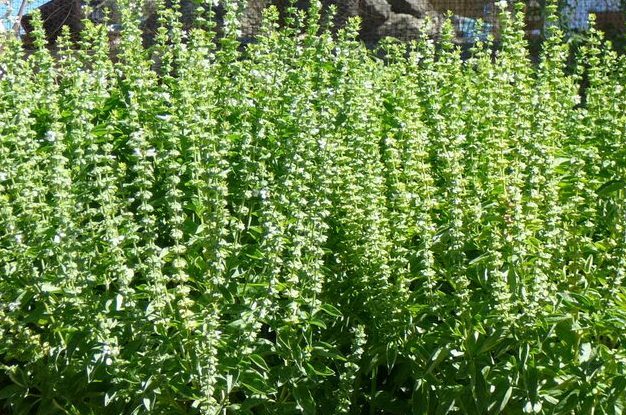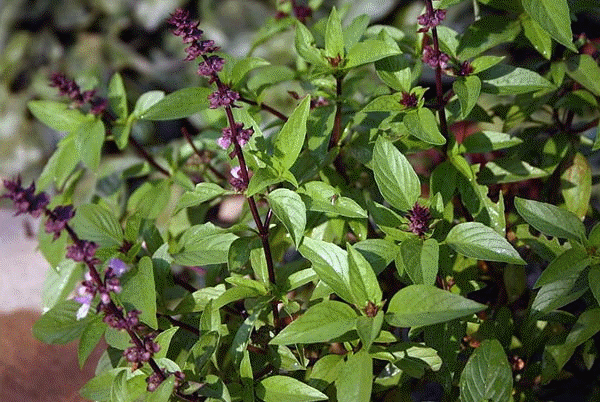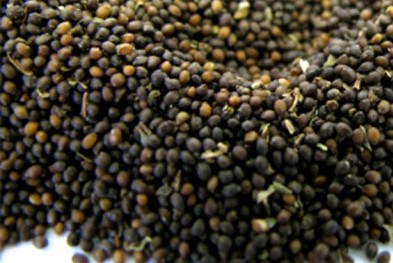Tulsi Farming Guide:
Today, we are going to learn Tulsi Farming Practices in India.

Introduction of the Tulsi Plant:
Basil or Sacred Tulsi is an excellent shrub and known as “queen of herbs” belongs to the family of “Lamiaceae”. This plant has been cultivated for centuries in India for multiple uses. Tulsi plant is a very sacred plant and worshiped by many Indians. Most of the Indians grow these plants in their houses and worship this plant. These plant leaves are also used in the production of oil. The oil of the Tulsi plant has about 72% eugenol and is comparable to clove oil. Eugenol is mainly used in cosmetics, perfumes, pharmaceuticals. These plant leaves are also used to make “Tulsi tea”. This plant also has many medicinal properties which made this plant popular. The parts of Tulsi generally used are its leaves, seeds & dried roots. This plant is being used in Ayurvedic medicines. Commercial/Organic cultivation of basil crop is picking up in India on a very large scale.
Health Benefits of Tulsi:
Some of the health benefits of Tulsi plants are as follows.
- Tulsi may cure fever, cold, cough & sore throat.
- Tulsi may beat stress.
- Tulsi may dissolve kidney stones.
- Tulsi may protect the heart.
- Tulsi may beat cancer.
- Tulsi may help in quitting smoking.
- Tulsi may reduce blood sugar levels.
- Tulsi may keep skin & hair healthy.
- Tulsi may help in respiratory disorders.
- Tulsi may cure a headache.
Main Varieties of Tulsi in India:
Currently, Purple type also called “Krishna Tulsi” & Green type also called “Sri Tulsi” are under commercial cultivation.

Local Names of Tulsi in India:
Basil (English),
Tulsi (Hindi),
Tulasi/Thulasi (Telugu),
Thulasi/Tirunirrippachai (Tamil),
Tulasi/Amli/Huli (Kannada),
Tulasi/Sivatulasi (Malayalam),
Tulsina/Sabje (Gujarati),
Tulsichi/Sabja/Tulasa (Marathi),
Imli/Tulasigidda/Tulasi (Punjabi),
Tulasi/Durlabha (Oriya),
Babui Tulsi (Bengali),
Tuulesi (Konkani),
Imli (Urdu).
The climate Required for Tulsi Farming:
Tulsi plants can be grown in a wide variety of climates including tropical and subtropical conditions. Long days with high temperatures are best for its growth and good oil content. However, It also thrives under partially shaded conditions but with low oil content. It requires moderate annual rainfall with humid conditions for better yield.
Read: How To Extract Tulsi Oil.
Soil Requirement for Tulsi Farming:
The Tulsi plant is a hardy plant and can be grown on a wide range of soils. However rich sandy loam soils with good internal drainage are ideal for its cultivation. Avoid highly alkaline, saline, and waterlogged soils. Well-drained soils with good organic matter will result in good vegetative growth of the plant. Soil pH of 5.5 – 7.0 is ideal for a better yield of Tulsi.
Land preparation in Tulsi:
The land or main field should be ploughed 2 or 3 times with a local/country plough or tractor to bring to the soil to a fine tilth. Add 15 tonnes of Farm Yard Manure in the soil for better yield. Make good internal drainage in the soil to avoid any waterlogging.
Propagation in Tulsi Farming:
The Tulsi plant crop can be propagated through seeds or cuttings.
-
Nursery Raising of Seedlings in Tulsi Farming:
Nursery raising of seedlings:-Prepare the nursery bed size of 4.5 m x 1.0 m x 0.2 m and apply Farm Yard Manure of 2 kg/square meter. Make sure the nursery bed/soil is covered with partial shade. Soil should be prepared to a fine tilth and worked up to 25 cm to 30 cm depth. As the basil seeds are very small in size, mix the seeds with sand in the ratio of 1:4. Then seeds should be sown in beds 8 weeks in advance of the monsoon. Generally, these seeds germinate in 1 week to 2 weeks and seedlings become ready for transplanting in the main field in about 6 to 7 weeks time @ 3 to 5 leaf stage.
-
Vegetative propagation or Propagation by cuttings in Tulsi Farming:
In this propagation method, terminal cuttings with 8 – 10 nodes &10 -15 cm length should be used. These cuttings should be planted in well-prepared nursery beds or polythene bags. Roots of the cuttings will be matured enough In about 4-6 weeks and ready for transplanting in the field. Row-to-Row space should be about 40 cm and space within the row should be about 40 cm.
Seed Rate in Tulsi Farming:
An average seed rate is about 120 grams/acre (or) 300 grams /ha.

Manures and Fertilizers in Tulsi Farming:
Apply Farm Yard Manure of 15 tonnes per hectare or 6 tonnes per acre as part of the land preparation. Fertilizers N @ 48 kg, P2O5 @ 24 kg and K2O @ 24 kg/acre (or) Fertilizers N @ 120 kg, P2O5 @ 60 kg and K2O @ 60 kg/ hectare should applied. Along with FYM, entire phosphorus and potassium and half nitrogen should be applied as basal dose and remaining nitrogen should be applied in split doses i.e. after first cutting and second cutting.
Read this: Project Report On Tulsi Cultivation In India.
Irrigation required for Tulsi Plants:
Irrigation should be given immodestly followed by transplanting. Carry the irrigation 2 times a week for 4 weeks. Thereafter, based on the rainfall and soil moisture, irrigation should be provided @ weekly interval. Irrigation is not required in the rainy season. Make sure the water drains well in the rainy season.
Weed Control in Tulsi Planting:
In Tulsi farming, 2 weedings are fair enough to control the weeds as these plants become bushy. One hoeing after two months of planting is fair enough. The first weeding should be carried out @ 1 month after planting. The second weeding should be carried out @ 2 months after planting. After each harvest, carry out the weeding task to avoid any weed growth.
Pests and Diseases in Tulsi Farming:
The major pest found in Tulsi cultivation is “Leaf rollers” and common diseases found are Powdery mildew, root-rot, and seedling blight.
To prevent these pests and diseases, the following control measures should be taken care of in Tulsi farming.
- To control the leaf rollers, spray the crop with 1% methyl (or) 0.2% malathion once noticed this insect.
- Spray the crop with 0.3% wettable sulfur to control the powdery mildew disease.
- Nursery beds should be drenched with a 0.1% solution of mercurial fungicide.
- To control the root rot and seedling blight diseases, adopt phytosanitary measures.
Harvesting of Tulsi Crop:
Tulsi crop will be ready for the first harvest after 3 months of planting. This crop should be harvested @ the full bloom stage. Cut the plants at least 15 cm above the ground level to ensure good regeneration for future harvests. After the first harvest, the next one can be carried out after 70 to 75 days interval. Cutting these plants on sunny days is preferred to obtain good yield and oil content.
The yield of Tulsi Crop:
Yield in any crop cultivation depends on the crop management practices and soil and cultivar. In the Tulsi crop, an average yield of 9000 to 14000 kg leaves per hectare can be achieved. This herb also contains oil (about 0.2%). The expected essential oil average yield could be about 10 to 25 liters per hectare.
In case if you are interested in this: Hydroponic Nutrient Chart.
- Economical Aquaculture: A Guide to Low-Budget Fish Farming
- 15 Common Planting Errors That Can Doom Your Fruit Trees
- How to Make Houseplants Bushy: Effective Tips and Ideas
- Innovative Strategies for Boosting Coconut Pollination and Yield
- Pollination Strategies for Maximum Pumpkin Yield
- The Complete Guide to Chicken Fattening: Strategies for Maximum Growth
- Natural Solutions for Tulip Problems: 100% Effective Remedies for Leaf and Bulb-Related Issues
- Revolutionizing Citrus Preservation: Towards a Healthier, Greener Future
- Natural Solutions for Peony Leaf and Flower Problems: 100% Effective Remedies
- Maximizing Profits with Avocado Contract Farming in India: A Comprehensive Guide
- Natural Solutions for Hydrangea Problems: 100% Effective Remedies for Leaf and Flowers
- The Ultimate Guide to Choosing the Perfect Foliage Friend: Bringing Life Indoors
- From Sunlight to Sustainability: 15 Ways to Use Solar Technology in Agriculture
- The Ultimate Guide to Dong Tao Chicken: Exploring from History to Raising
- The Eco-Friendly Makeover: How to Convert Your Unused Swimming Pool into a Fish Pond
- Mastering the Art of Delaware Chicken Farming: Essentials for Healthy Backyard Flocks
- 20 Best Homemade Fertilizers for Money Plant: DIY Recipes and Application Methods
- How to Craft a Comprehensive Free-Range Chicken Farming Business Plan
- Brighten Your Flock: Raising Easter Egger Chickens for Beauty and Bounty
- How to Optimize Your Poultry Egg Farm Business Plan with These Strategies
- Subsidy for Spirulina Cultivation: How Indian Government Schemes Encouraging Spirulina Farmers
- Ultimate Guide to Raising Dominique Chickens: Breeding, Feeding, Egg-Production, and Care
- Mastering the Art of Raising Jersey Giant Chickens: Care, Feeding, and More
- Ultimate Guide to Raising Legbar Chickens: Breeding, Farming Practices, Diet, Egg-Production
- How to Raise Welsummer Chickens: A Comprehensive Guide for Beginners
- How to Protect Indoor Plants in Winter: A Comprehensive Guide
- Ultimate Guide to Grow Bag Gardening: Tips, Tricks, and Planting Ideas for Urban Gardeners
- Guide to Lotus Cultivation: How to Propagate, Plant, Grow, Care, Cost, and Profit
- Agriculture Drone Subsidy Scheme: Government Kisan Subsidy, License, and How to Apply Online
- Ultimate Guide to Raising Araucana Chickens: Breed Profile, Farming Economics, Diet, and Care
- Bringing Hydroponics to Classroom: Importance, Benefits of Learning for School Students
- Ultimate Guide to Raising Polish Chickens: Breed Profile, Farming Economics, Diet, and Care
- Ultimate Guide to Raising Australorp Chickens: Profile, Farming Economics, Egg Production, Diet, and Care
Want to know how to marke Tulasi (Holy Basil).
You better contact herbal and cosmetic companies like Himalaya, Patanjali, Ayush..etc.
can I know in which place does Tulasi grown commercially in Andhra and Telangana
In fact Holy basil (Tulsi) can be grown throughout India. you can find commercial Tulsi cultivation surrounding of Hyderabad. I personally visited the farm at Shankarpally.
can you please share the details of Farms near Hyderabad doing Tulsi. Need to visit them about to start 15 acrs of Plantation
Well, We have visited some farms (done by farmers not by commercial people) of Tulsi Near Shankarpally a year ago. Not sure weather they still exist. Let you know if we come across any.
How can i establish contact with herbal companies like patanjali and himalaya
I am looking for contract farming. My field is irrigated, in hanumangarh rajasthan. Tulsi, aloe Vera or other medicine plants.
Can you please share the details of tulsi farming in near bangalore in karnataka and farms doing near bangalore need to visit them and start tulsi farming please guide me
Hi, I want to start the farming of Tulasi/Tulasi, let me know the marketing details in and around Guntur, Andhra Pradesh.
Well, If you are planning Tulasi Farming on commercial scale, you should ensure the marketing channel or buyback agreement or contract farming proposal from any herbal company like Patanjali, Himalaya or Ayush.
hi, i want to know the methods of producing eugenol (thulsi oil). please give suggestions and explanations.
We will update soon about Tulsi Oil Extraction Process and Project Report soon.
Can you please tell us Sabja or Chia seeds cultivation process?
We will update Chia seed farming or Sabja Farming next week. Please check back.
Read this: Tulsi Farming Project Report.
I am also interested to know about Tulsi marketing and I am from Latur, Maharashtra. please tell me information about it.
If you are growing Tulsi in large scale, marketing will be tough unless you have any contract farming agreement.
Here is some information: Tulsi Farming Project Report.
Hello, can I get the contact details of the farmer you mentioned from shankarpally. It would be grateful if you could provide some way to contact them or any other person who cultivated tulasi near mahaboobnagar or Nagarkurnool area (telangana). Thank you very much.
I want to plant tulsi near Ghaziabad around 04 acre.Pl suggest market place, investment & income.
Here is Project Report: Tulsi Farming Project Report.
This is the best site for knowledge, but I want to know how many seeds need for one bigha?
Tulsi can properly grow in Nanded district
Hello sir
I have 10 acres of agricultural land.I want to know details of commercial cultivation of basil as I am planning to start it ASAP. What are the target companies? How profit is calculated kindly guide me.
sir i want to cultivate of tulsi so i want to know how much profit outcome by cultivate of tulsi
can u suggest me about whole things
hi together
i am interested in starting this. any inputs is appreciated.
-br
pradeep
Can I know in Karnataka, I m interested.
Can I know where can I grow Tulasi in Bihar. Nearby patna is the soil and moisture good for it